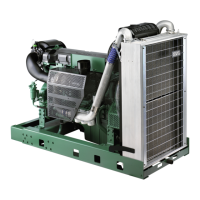Do you have a question about the Volvo Penta TAD1643VE-B and is the answer not in the manual?
Explains the prioritization of safety warnings: Danger, Warning, Caution, Important, and Notice.
Importance and examples of personal protective equipment for safe operation and maintenance.
Recommends wearing safety glasses to prevent eye injury from sparks, sprays, or chemicals.
Warns about fire and explosion risks related to fuels, sparks, and battery hydrogen.
Instructions on immobilizing the engine and using warning notices before starting work.
Importance of operating the engine in well-ventilated areas to remove exhaust gases.
Warns about the safety risks of approaching or working with a running engine's moving components.
Advises against using start spray due to explosion risk in the inlet manifold.
Details checks required before starting the engine, including air filters and electrical systems.
Stresses stopping the engine and disconnecting power before working on electrical systems.
Cautions against opening hot coolant filler caps due to pressure and hot fluid spray risk.
Warns about hot oil hazards and ensuring the lubrication system is not pressurized before work.
Highlights fire and explosion risks during refueling and the necessity of stopping the engine.
Stresses using recommended fuel to prevent malfunctions, increased consumption, and potential overspeeding.
Warns about high fuel pressure risks and the need for safety goggles during leak detection.
Warns against open flames or sparks near batteries due to explosion risk from short circuits.
Explains the electronic system for engine control, including fuel regulation and diagnostic functions.
Introduces the DCU as a digital instrument panel for engine control, monitoring, and diagnostics.
Details the steps for starting the engine using the DCU panel, including menu navigation.
Describes how to manually activate engine pre-heating, especially in cold conditions.
Details how fault codes are displayed and accessed through the diagnostics menu.
Covers parameter settings for application, units, language, and external inputs in the control system.
Describes the three types of messages (Alarm, Warning, Message) based on severity and color coding.
Outlines essential checks before starting the engine, including oil level and fuel valves.
Details the steps for starting the engine with or without pre-heating, including warm-up advice.
Provides recommendations for starting the engine in extreme cold, including fuel, oil, and battery considerations.
Repeats the warning against using start spray due to explosion risks.
Details the safe procedure for using auxiliary batteries to start the engine, emphasizing correct connections.
Explains how the EMS system generates fault codes and alarms based on abnormal signals.
Explains the importance of a high idle warm-up period before shutdown to cool the turbo and equalize temperatures.
Provides step-by-step instructions for stopping the engine using the STOP button and main switch.
Explains the purpose of the diagnostic function in monitoring, controlling, and protecting the engine.
Provides a table linking engine symptoms to possible causes and referring to diagnostic functions.
Step-by-step instructions for removing and installing drive belts, including tensioner use.
Step-by-step instructions for removing and installing alternator belts and water pump drive belts.
Provides guidance on checking oil level using the dipstick, distinguishing between stopped and running engine readings.
Details the process for changing engine oil, including draining and filling, and proper disposal of old oil.
Step-by-step instructions for replacing oil filters, including cleaning mating surfaces and tightening.
Step-by-step guide for replacing the engine fuel filter, emphasizing cleanliness and proper tightening.
Provides instructions for checking and topping up coolant levels in TWD16 and TAD16 systems, with safety warnings.
Covers battery hazards (fire, explosion, electrolyte) and maintenance practices like cleaning and charging.
Step-by-step guide for safely disconnecting and connecting batteries, emphasizing correct polarity.
| Engine Model | TAD1643VE-B |
|---|---|
| Number of Cylinders | 6 |
| Engine Speed at Max Power | 1800 rpm |
| Fuel System | Common Rail |
| Engine Type | Diesel |
| Aspiration | Turbocharged |
| Emission Compliance | EU Stage V |
| Cooling System | Water-cooled |
| Bore x Stroke | 144 mm x 165 mm |











